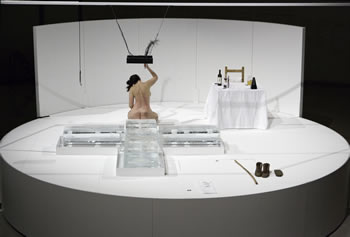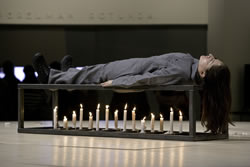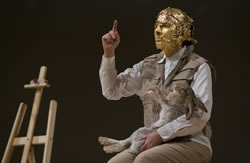
Marina Abramovic Repeats: Pain, Art, and
Theater
By Marla Carlson
The Lips of Thomas
(Seven Easy Pieces)
By Marina Abramovic
Guggenheim Museum
(closed)
I was about fifteen minutes late for the
start of Marina Abramovic's November 15, 2005, appearance at the
Guggenheim Museum, a re-performance of her 1975 body-art action,
The Lips of Thomas. She was using a razor blade to cut
the first line of a five-pointed star drawn on her stomach. The
place was packed. Abramovic, naked, was installed on a round platform
in the middle of the rotunda. Spectators filled the floor in front
of her and lined the first few spirals of the museum's ramp, with
a scattering higher up. Although one could safely assume that
those on the floor had come to see Abramovic, at least some of
the others must have been caught on their descent from the museum's
concurrent Russia! exhibit.
When the first cut was complete, Abramovic
blotted it with a white cloth. Slipping her feet into boots that
waited nearby, putting on a military cap, and picking up a heavy
wooden staff, she stood and cried, her belly heaving, tears streaming
down her cheeks as she, and we, listened to a Russian folk song.
She lay down on blocks of ice arranged in the shape of a cross,
her body shaking; then knelt on the floor and whipped herself;
finally sat at the table and slowly ate a spoonful of honey and
took a sip of red wine.
Abramovic repeated these actions, varying
the sequence, until midnight. A metronome ticked away. She seemed
to be pacing herself. In 1975, she had performed the actions in
the sequence described in the program: she ate a kilo of honey,
drank a liter of red wine, broke the wine glass with her right
hand, cut the star on her stomach, whipped herself until she no
longer felt pain, and then lay down on the ice. Thirty years ago,
the spectators (in a gallery, not a museum) ended the piece by
removing the ice after 30 minutes. Some of them were surely familiar
with Abramovic's earlier Rhythm series, from which she required
rescue more than once, and with other actions she had performed
that same year: Art Must Be Beautiful. Artist Must be Beautiful
(in which she brushed her hair simultaneously with a metal brush
and metal comb until her face and hair were damaged); Role
Exchange (she exchanged places for four hours with an Amsterdam
prostitute); Freeing the Voice (she lay on the floor
with her head tilted back and screamed for three hours, stopping
when she lost her voice); Freeing the Memory (she free-associated
until no more words came to her); and Freeing the Body
(she wrapped her head in a black scarf and moved to a drumbeat
for eight hours, stopping when she collapsed).
Given the explicit feminist orientation
of Artist Must Be Beautiful and Role Exchange,
and the theme of a painful liberation from constraints and social
conditioning in the other three actions, in 1975 one might have
reasonably read The Lips of Thomas as a ritual escape
from a repressive culture. The Christian references in the flagellation
and the cross of ice are obvious, and some spectators might recognize
the honey and wine as elements of Orthodox ritual. The star reads
as a symbol of Yugoslavia's Communist regime. Abramovic uses her
body to manifest sources of conflict and suffering, and spectators
invest these cultural traces with unpredictable personal significance.
Many are no doubt oblivious to the symbolism and register only
the piece's ritualistic aura.
The event was a test of endurance for spectators
as well as for the artist. Each person had to decide when to leave,
whether to stay through the boredom and the pain of standing for
hours or sitting, unsupported, on the floor. Aside from the half-hour
I spent (with some guilty feelings) in the museum café, I stayed
with Abramovic until midnight. Placing real physical pain within
an aesthetic framework throws the spectator's ethical relation
to the spectacle into question. My own engagement with painful
performance is born of a desire to understand what happens when
we watch such spectacles and why we do so. Yet I remain disturbed
by my interest and reluctant to look: I cannot ask another person
to injure herself in order to observe my own response. I can ask
someone to play Ophelia for me or to dance Giselle, but how can
I ask her to slice her skin, even if I know that she is a "cutter"?
This was certainly no "command" performance undertaken for me,
but Abramovic solicits her audience's emotional engagement by
offering up her pain. I talked to other people who felt, as I
did, that we owed it to her to stay. In fact, she has defined
the exchange of energy with her audience as her primary interest
since the late 1990s, and for long intervals between actions,
she simply gazed out at us. Aside from this sense of responsibility,
I also wanted to see what would change for me, and for her, over
the course of seven hours.
When the time was up and the guards began
trying to empty the museum, the still sizable audience applauded
for perhaps ten minutes. As the night went on, each variety of
action took on a different valence: the wine and honey seemed
to nurture and soothe her, the flagellation to purge, in contrast
to the purely passive ordeal of lying on the ice. Abramovic eventually
stopped jerking around on the ice and crying out as she lay down
on it. By 8:00, however, she continued to shiver as she sat at
the table after lying on the ice, her body trying hard to warm
up. After whipping herself, to which she continued to react vocally,
she looked intent, energized, powerful. The flagellation seemed
to me like an athletic event. Perhaps because I knew The Lips
of Thomas so well as a piece of body-art history, I watched
the cutting action unmoved. But the space became very quiet at
those points, no movement, little whispering. On the third cut,
someone called out, "you don't have to do it again." Obviously
others were more disturbed by it than I, and many turned away
from the flagellation.
I had a strong desire to read Abramovic's
affect throughout, but her reaction to the ordeals seemed largely
physical. Her face remained impassive as she cut her stomach,
in sharp contrast to her weeping during the "Young Communist"
segment, which was not part of the 1975 action. In addition to
wearing the cap and boots this time, which evoked her Eastern
Bloc upbringing, she sometimes opened out the cloth with which
she blotted the cuts on her stomach and tied it to the staff,
waving it as a flag. These accessories and the music suggested
an association between her tears and the pain of memory, clearly
marking Abramovic's cross-over from the visual art world into
a performance genre more closely allied with theater. The entire
week-long event at the Guggenheim smacked of theater, a fact that
met with distaste from some fans of conceptual art.
 During
the week, Abramovic also re-performed Bruce Naumann's Body
Pressure (1974), Vito Acconci's Seedbed (1972),
VALIE EXPORT's Action Pants: Genital Panic (1969), Gina
Pane's The Conditioning (1973), and Joseph Beuys's How
to Explain Pictures to a Dead Hare (1965). The museum provided
a program with the name of each night's piece, the originating
artist, its performance location and date, the original duration
of each event, and a statement by the originating artist. In a
letter to the New York Times, the performance artist
and sculptor Tom Marioni objected that Abramovic thus became an
actress, not an artist. Clearly this distinction remains important
to Marioni and to Chris Burden, who would not cooperate with the
project. To me, the more interesting point is that Abramovic herself
has been pointedly blurring this line for fifteen years. In the
mid-1990s, she told Beatrix Ruf and Hans-Peter von Däniken: "In
the seventies, the theater was the enemy of performance artists.
It was considered a fake, a staged experience. In the nineties
now, my attitude has changed completely.… The audience who now
come to the theater to see my work see both a stage-play and a
performance."
During
the week, Abramovic also re-performed Bruce Naumann's Body
Pressure (1974), Vito Acconci's Seedbed (1972),
VALIE EXPORT's Action Pants: Genital Panic (1969), Gina
Pane's The Conditioning (1973), and Joseph Beuys's How
to Explain Pictures to a Dead Hare (1965). The museum provided
a program with the name of each night's piece, the originating
artist, its performance location and date, the original duration
of each event, and a statement by the originating artist. In a
letter to the New York Times, the performance artist
and sculptor Tom Marioni objected that Abramovic thus became an
actress, not an artist. Clearly this distinction remains important
to Marioni and to Chris Burden, who would not cooperate with the
project. To me, the more interesting point is that Abramovic herself
has been pointedly blurring this line for fifteen years. In the
mid-1990s, she told Beatrix Ruf and Hans-Peter von Däniken: "In
the seventies, the theater was the enemy of performance artists.
It was considered a fake, a staged experience. In the nineties
now, my attitude has changed completely.… The audience who now
come to the theater to see my work see both a stage-play and a
performance."
Abramovic first re-performed The Lips
of Thomas in European and American theatres and opera houses
in 1993 as part of a work called Biography, which used
a recorded autobiographical narrative to contextualize the brief
re-enactment of many of her early art actions. The elements of
The Lips of Thomas that she chose to include, the star-cutting
and the flagellation, referred not only to her personal history
but also to an opposition between God and the state upon which
she focused in telling that history: Her mother was an atheist
and partisan, her father a communist, and both parents participated
in Yugoslavia's Communist Revolution. Interestingly enough, her
maternal grandfather was a Patriarch of the Orthodox Church, making
her childhood a mixture of military discipline at home and religious
life with her grandmother. By re-inscribing these symbols with
the details of her personal biography, Biography made
them both concrete and mutable. The Guggenheim version replaced
the narrative with costume, props, and the song "Slavic Souls,"
sung in Russian with a xeroxed translation available at the entrance
desk. The actions thus hovered between theatre and anti-theatrical
body art. There was no question of the artist losing control.
And like the proscenium stage configuration that separated Abramovic
from her audience when she performed Biography, security
precautions at the museum eliminated the ready access to the performer's
body that was part of her gallery settings in the 1970s. There
was no possibility for spectators to end the action by "rescuing"
her and no danger of provoking that sort of intervention.
 More
than anything else, Abramovic's re-performed body art actions
served this time as icons for spectators familiar with her work.
Seven Easy Pieces, dedicated to Susan Sontag and curated
by Nancy Spector and Jennifer Blessing, provided a most unusual
opportunity to encounter this kind of work in the flesh. For all
its visceral impact, body art is always mediated, if not by recordings
and reports then at least by the framework within which it is
performed.
More
than anything else, Abramovic's re-performed body art actions
served this time as icons for spectators familiar with her work.
Seven Easy Pieces, dedicated to Susan Sontag and curated
by Nancy Spector and Jennifer Blessing, provided a most unusual
opportunity to encounter this kind of work in the flesh. For all
its visceral impact, body art is always mediated, if not by recordings
and reports then at least by the framework within which it is
performed.
Consider the title of this piece, the meaning
of which is hardly self-evident. Because I have never come across
an explanation or even a discussion, I initially put the title
together with the sacrificial imagery and thought of "Doubting
Thomas," who finds proof of the resurrection in touching the lips
of Christ's wound. I then added in Abramovic's stated desire to
produce gaps in her audience's understanding: She told Hans Ulrich
Obrist that her performances, like the sculptural objects that
she creates, are designed to create for the spectators "some kind
of mental gap so that they can't explain it rationally. They will
look for tricks, and when they can't find the trick . . . their
knowledge . . . will have to collapse . . ." and "they will have
a completely different way of seeing things." I can't say that
the performance caused my knowledge to collapse, but Abramovic's
aim makes sense of her title. The Lips of Thomas positions
her body and its sensations, pain most particularly, at the center
of a mystified circle, available for perception but defying rational
comprehension. Yet I suspect that she had in mind a different
Thomas; that is, St. Thomas Aquinas, whose Summa Theologica
addresses the question of whether God should be praised with the
lips. After noting all the scriptural arguments for and against
verbal devotions, Aquinas answers that we praise God with our
lips to arouse our own devotion and that of other people, but
that "it profits one nothing to praise with the lips if one praise
not with the heart." Read in this context, Abramovic's wordless
Lips of Thomas pulls her heart back and forth between
her family's incompatible Christian and Communist devotional practices.
I don't know how far other members of Abramovic's
audience at the Guggenheim went to interpret her title, or how
much they knew about her life and work. But certainly everyone
was aware that she was re-performing art actions that had originally
been performed some 30 years ago in a different context. To be
a member of the audience for conceptual art typically entails
"consuming" the concepts behind the events, and a significant
part of the ultimate "audience" for such events never witnesses
them. Many, in fact, never even see photos or videos. Word of
mouth has an important impact, for both the consumers and the
performers. Abramovic, for example, told Janet Kaplan that she
heard as a young artist in Yugoslavia that Chris Burden was arrested
after being crucified on a Volkswagen that was driven around Los
Angeles. In fact, Burden's Trans-fixed (1972) was much
less dramatic: after a doctor affixed Burden to the car with nails,
a few friends pushed it out of the garage, took the picture, and
pushed it back in. Yet the story that Abramovic heard in Yugoslavia
influenced the challenges that she set herself during the mid-1970s
and sparked her desire to re-perform the performances of other
artists--a desire finally fulfilled at the Guggenheim in 2005.
Knowing all this, one cannot help wondering what stories and desires
Seven Easy Pieces will eventually spawn.
